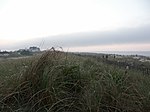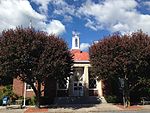Quogue station

Quogue was a station stop along the Montauk Branch of the Long Island Rail Road and the station was built around June, 1875. During construction the station was moved by the village "on a Sunday morning" from its original and current location to a location on Old Depot Road. The second depot was built around 1882 and later was moved to a private location around 1905. The third depot was built around 1905 and at some point was elevated for the bridge over the former New York State Route 113. The station house was razed around April, 1964 but the station stop itself continued to operate until March 16, 1998. This station, along with nine others around that time were closed due to low ridership, was deemed not cost-effective to rebuild with high-level platforms to support the new C3 railcars the LIRR was procuring at the time.
Excerpt from the Wikipedia article Quogue station (License: CC BY-SA 3.0, Authors, Images).Quogue station
Station Road,
Geographical coordinates (GPS) Address Nearby Places Show on map
Geographical coordinates (GPS)
| Latitude | Longitude |
|---|---|
| N 40.838055555556 ° | E -72.601388888889 ° |
Address
Station Road 1
11959
New York, United States
Open on Google Maps








